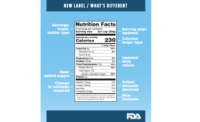Checking out the challenges of the FDA’s mandated front-of-label nutrition labeling
FDA’s laser focus on nutrients to limit could further the underconsumption of nutrient-rich dairy products recommended by the DGA.

Photo courtesy of Bet_Noire via gettyimages.com
The U.S. Food and Drug Administration (FDA) plans to announce a proposed regulation this year that will require front-of-package nutrition labeling (FOPNL) on food packages, a move aimed at providing consumers with at-a-glance nutrition information to help them quickly and easily make informed food selections.
While the U.S. food industry has used voluntary FOPNL schemes for many years, FDA is researching and drafting a mandatory FOPNL scheme that focuses on nutrients that most Americans should limit in their diet: added sugars, sodium and saturated fat. Unfortunately, this labeling would work against the recommendations of the 2020-2025 Dietary Guidelines for Americans (DGA) report and FDA’s goal of improving diet-related health outcomes for Americans.
FDA’s laser focus on nutrients to limit could further the underconsumption of nutrient-rich dairy products recommended by the DGA. For example, whole milk — recommended for consumption by 12-24 month old children — could be required to declare it is high in saturated fat. Chocolate milk, a good source of 13 essential nutrients, could be required to declare it is high in added sugars.
Yet, diet soda with no sodium, saturated fat or added sugar, or beneficial nutrients, might not have to bear FOPNL at all. In this scenario, the beverage devoid of nutrients could appear to be a healthier choice than milk which we know is not the case.
IDFA continues to advocate for FDA nutrition policies that align with one another and the DGAs. We are particularly concerned that FOPNL could conflict with FDA’s new “healthy” claim and/or healthy symbol. And while the agency claims it is mandating FOPNL to reduce food related chronic disease in the U.S., the agency is unable to explain how it will measure the success of this new policy. And we are concerned about the huge costs to the dairy industry and the many unknowns about if or how consumers will respond to FOPNL on food labels.
Recently, the International Food Information Council (IFIC) shared results of its consumer studies on FOPNL formats. IFIC tested plans similar to those tested by FDA along with other systems that presented more nutrition information in addition to saturated fats, added sugars and sodium. IFIC’s results indicate there is no one single FOPNL format that is best for consumers to identify the healthiest or least healthy choices. In fact, including information on calories and fiber, in addition to information on the three nutrients to limit, improves the correct selection by consumers of the healthiest label.
IFIC’s research underscores the need to understand how FOPNL will affect consumer attitudes and purchasing behaviors, including which foods they will buy and serve to their families. It is extremely important to understand if FOPNL steers consumers away from purchasing already under-consumed nutrient-dense foods. The IFIC research also found FOPNL schemes with additional information, including calorie content or nutrients to encourage, can increase the accuracy of consumers’ identification of healthier options.
When Canada implemented its mandatory FOPNL scheme, it exempted certain dairy products that met a threshold for calcium from the requirements to assure continued consumption of these nutrient-rich foods. IDFA supports a balanced FOPNL scheme, reflective of the full nutrient profile of food, to prevent the need for such exemptions.
While FOPNL may provide useful information to consumers, it is imperative that any scheme mandated by FDA not result in unintended consequences, including furthering under-consumption of foods and beverages that provide important nutrients, such as dairy products.
Roberta Wagner is senior vice president of regulatory and scientific affairs at IDFA.
Michelle Albee Matto is associate vice president, regulatory affairs and nutrition at IDFA.
Looking for a reprint of this article?
From high-res PDFs to custom plaques, order your copy today!







